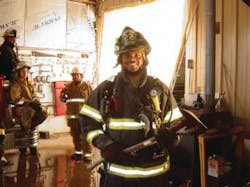"We are professional athletes," the captain with the St. Andrews Fire Department in Charleston, S.C. said. "This is something we need to embrace. What we do is far more important."
Kinney -- who began his career in the fire service as a junior firefighter at the age of 13 -- stressed the importance of fitness and health to attendees at FDIC in Indianapolis last week.
He said that firefighters -- along with public safety officers and members of the military -- are considered to be tactical athletes by the National Strength and Conditioning Association.
The organization even has a fitness program created with members of the fire service in mind.
He said that while there are plenty of resources out there, fitness is still a tough topic for firefighters and isn't always well received.
"We have the 'it can't happen to me attitude,' " he said. "Changing the culture is critical," he said. "If we aren't trained and fit to do the job, we aren't adequate."
There are things firefighters don't think about, Kinney said -- including canceled fire calls and false alarms -- that can negatively affect the body.
"What happens when the tone goes off?" he said. "Just that alone -- studies have shown -- triggers a physiological response."
He said that while ramping up for a call can get firefighters motivated, if they don't get a chance to relieve that adrenaline rush, it can be taxing on their systems.
"We get off the rig and jump the (stationary) bike," he said. "We give ourselves a little moderate exertion so we're ready for the next call."
Kinney first learned the importance of being fit on the job while he was with the Archer Fire Department during his senior year at the University of Florida, where he played tight end for the Gators.
On Aug. 31, 1999, the call came in for a fire at the Monterey Boat Plant in Archer.
He was on the first due engine and his crew saw flames shooting close to 100 feet in the air.
"We did everything we could and then got the evacuation tones," he said. "One of the firefighters I was with, Paul James, collapsed. I thought, 'What do we do?' I was very scared."
Another firefighter was with them and attempted to help Kinney carry James, but that firefighter soon became exhausted. Fearing he also would collapse, Kinney told him to evacuate and said he would stay to rescue James.
"I carried Paul, picked him up and cradled him like a baby and carried him out," he said. "The training went out the window and it was all adrenaline."
He had to travel the distance of several football fields before they were to safety.
"If that happened today, I'm not sure if I could do it," he said, adding that he was young and in football shape at the time of the incident.
When Kinney retired from football in 2006, he thought the hard workouts were over, but soon realized they were not.
"It's even more important now," he said. "I have to be in top physical shape to do my job."
He stressed the importance of other firefighters realizing their worth and the need to be in shape. He said firefighters spend so much time maintaining equipment in the firehouse, but won't take care of themselves.
"You work to maintain yourself," he said, adding that it was the same in the NFL. They didn't train to increase strength or speed. They did it to decrease injuries.
He said firefighters must be fit because they never know when they'll get a call. Unlike other dangerous jobs such as long shore and lumber workers who face the maximum risk every day, firefighters do not.
Despite this, Kinney said the death rate among firefighters is much higher.
He also said that a focus has to be placed on cardiovascular training and that not all weight training is beneficial.
"Are you pulling down ceilings with one body part or breaching doors with one body part?"
He suggested that instead of using typical Olympic-style lifts, to work with equipment such as kettlebells that work entire areas of the body.
As far as gaining access to equipment for cash-strapped departments, he said to think outside the box.
His department sponsors local YMCA soccer teams and all of the members get memberships. It only costs about $500 per year.
In tough economic times when budgets are in focus, Kinney said there is a need for firefighters to prove their worth and that the best way to do that is by showing the public that they are fit to do their job.
"The amount of money spent on personnel far outweighs everything else," he said. "We are the most important tool in the fire service."
About the Author
Paul Peluso
Staff Writer
Paul Peluso is a Firehouse.com staff writer and has worked for the Web site since 2006. Previously, he worked as a reporter for several community newspapers located in the suburbs of Baltimore, Md. Since joining the newsteam, Paul has covered various fire service issues including fire sprinklers, grants, line of duty deaths and technology. While he started out at the Beltsville, Md. office, he has since moved to Florida where he works out of his home office in Tampa.

